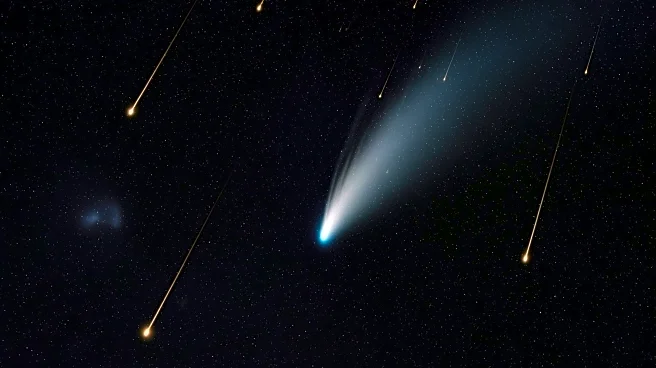What's Happening?
Skywatchers are in for a treat as the Orionid meteor shower, caused by Halley's Comet, peaks on October 20-21, coinciding with the bright appearances of two newly discovered comets, Lemmon and SWAN. The
Orionids, part of fall's meteor season, are expected to produce around 20 meteors per hour, with meteors entering Earth's atmosphere at high speeds. The shower is named after the constellation Orion, where the meteors appear to originate. The peak coincides with a new moon, providing optimal viewing conditions due to the absence of moonlight. Comet Lemmon, discovered in Arizona, will be visible in the northwest sky, while Comet SWAN, spotted by NASA's Solar Dynamics Observatory, will be visible in the southern sky. Both comets will be best viewed shortly after sunset, potentially visible to the naked eye from dark sky locations.
Why It's Important?
The Orionid meteor shower is a significant astronomical event, offering a spectacular display for stargazers and contributing to public interest in space phenomena. The shower, along with the bright appearances of Comets Lemmon and SWAN, provides an opportunity for amateur astronomers and the general public to engage with celestial events, fostering interest in astronomy and science education. The visibility of these comets, particularly during the Orionids' peak, enhances the experience, allowing observers to witness multiple astronomical phenomena simultaneously. Such events can inspire future generations to explore careers in science and technology, contributing to advancements in space exploration and research.
What's Next?
As the Orionid meteor shower peaks, astronomers and enthusiasts will continue to monitor the visibility and trajectory of Comets Lemmon and SWAN. Observations from this event may provide insights into the behavior and composition of these comets, contributing to the broader understanding of cometary science. The data collected during the shower could also inform future predictions and models of meteor showers, aiding in the planning of observational campaigns. Additionally, the public's engagement with this event may lead to increased interest in upcoming astronomical phenomena, encouraging participation in community stargazing events and educational programs.
Beyond the Headlines
The Orionid meteor shower and the appearance of Comets Lemmon and SWAN highlight the dynamic nature of our solar system, where celestial bodies interact and create observable phenomena. These events underscore the importance of continued investment in astronomical research and technology, as understanding the movements and characteristics of comets and meteors can provide valuable information about the solar system's history and evolution. Furthermore, the public's fascination with such events reflects a broader cultural appreciation for the natural world and the mysteries of space, emphasizing the role of science communication in bridging the gap between scientific discovery and public awareness.













